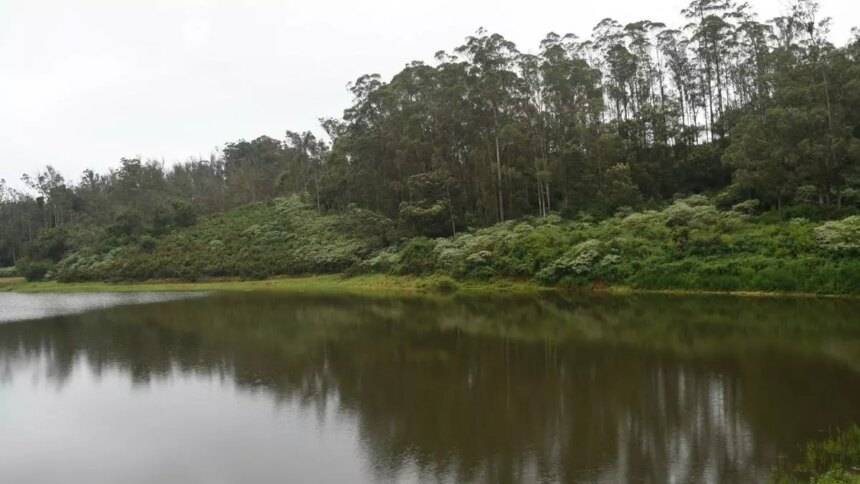Main Points In Hindi (मुख्य बातें – हिंदी में)
-
जल भंडारण में कमी: भारत के 155 प्रमुख जलाशयों में जल भंडारण इस सप्ताह 2 प्रतिशत घटकर 83 प्रतिशत पर आ गया है, लेकिन यह पिछले वर्ष और पिछले 10 वर्षों के औसत से अधिक है।
-
मानसूनी बारिश की कमी: दक्षिण-पश्चिम मॉनसून की समाप्ति के बाद जलाशयों का स्तर कम हो रहा है, विशेष रूप से 1 अक्टूबर से 21 नवंबर के बीच अधिकांश जिलों में रिकार्ड की गई कम वर्षा के कारण।
-
भंडारण की स्थिति: सीडब्ल्यूसी के आंकड़ों के अनुसार, 103 जलाशयों में से 80 प्रतिशत से अधिक भरे हुए हैं, जबकि 15 जलाशयों का भंडारण 50 प्रतिशत से कम है। पंजाब, बिहार और हिमाचल प्रदेश में सामान्य से 52 प्रतिशत, 36 प्रतिशत और 30 प्रतिशत कम भंडारण है।
-
कृषि के लिए सकारात्मक संकेत: पिछले वर्ष की तुलना में अधिक भंडारण और मिट्टी की बेहतर नमी के कारण रबी सीजन के लिए स्थिति अनुकूल दिखाई दे रही है।
- भविष्यवाणी: आईएमडी ने अनुमान लगाया है कि उत्तर-पूर्व और दक्षिणी क्षेत्रों में अगले दिनों में सामान्य से अधिक बारिश होने की संभावना है, जिससे भंडारण में सुधार हो सकता है।
Main Points In English(मुख्य बातें – अंग्रेज़ी में)
Here are the main points from the article:
-
Reservoir Storage Levels: As of this week, the water storage in India’s 155 major reservoirs has decreased by 2 percentage points, now standing at 83% of total capacity. However, this level is still higher compared to last year and the average of the past decade.
-
Post-Monsoon Rainfall Deficiency: Following an 8% increase in rainfall last month, the storage levels began to decline after the southwest monsoon receded. The India Meteorological Department (IMD) reported that 64% of districts had below-average rainfall during the post-monsoon period from October 1 to November 21.
-
Regional Variations: While the overall seasonal rainfall was 11% below normal, the northwestern region experienced a dramatic 75% deficit. In contrast, the eastern and northeastern regions saw above-average rainfall, contributing to varying storage levels across different states.
-
State-Specific Storage Situations: States like Punjab, Bihar, and Himachal Pradesh showed significant deficits in storage levels, being 52%, 36%, and 30% below normal, respectively. Conversely, some reservoirs like those in Rajasthan have reported a favorable storage level of 93%.
- Forecast and Future Outlook: The IMD anticipates that reservoir levels in the northeastern and southern states may improve due to expected above-normal rainfall, which could positively impact water availability for the upcoming rabi season.


Complete News In Hindi(पूरी खबर – हिंदी में)
भारत के 155 प्रमुख जलाशयों में जल भंडारण इस सप्ताह 2 प्रतिशत अंक और घटकर क्षमता का 83 प्रतिशत रह गया। हालाँकि, केंद्रीय जल आयोग (सीडब्ल्यूसी) के आंकड़ों से पता चलता है कि स्तर पिछले साल और पिछले 10 वर्षों के औसत (सामान्य स्तर) से अधिक था।
पिछले महीने 8 प्रतिशत अधिक वर्षा के बाद दक्षिण-पश्चिम मॉनसून के वापस चले जाने के बाद जलाशयों का स्तर कम होना शुरू हो गया है। हालाँकि, भारत मौसम विज्ञान विभाग (IMD) के आंकड़ों से पता चला है कि 1 अक्टूबर से 21 नवंबर के बीच 720 जिलों में से 64 प्रतिशत में मानसून के बाद बारिश कम थी।
आईएमडी ने कहा कि 21 नवंबर तक देशभर में मौसमी बारिश 11 फीसदी कम थी। उत्तर-पश्चिम में 75 प्रतिशत की कमी इसका मुख्य कारण है, जबकि केवल पूर्व और उत्तर-पूर्व में ही अधिक वर्षा हुई है। मध्य क्षेत्र में 18 प्रतिशत कम बारिश हुई और दक्षिणी क्षेत्र में 2 प्रतिशत कम बारिश हुई।
सबसे कम भंडारण
प्रमुख जलाशयों की लाइव स्टोरेज स्थिति पर सीडब्ल्यूसी के साप्ताहिक बुलेटिन के अनुसार, भंडारण 180.852 बीसीएम क्षमता में से 150.639 बिलियन क्यूबिक मीटर (बीसीएम) था। पंजाब, बिहार और हिमाचल क्रमशः सामान्य से 52 प्रतिशत, 36 प्रतिशत और 30 प्रतिशत कम भंडारण वाले राज्य बने हुए हैं।
इन घटनाक्रमों के बावजूद, पिछले वर्ष की तुलना में अधिक भंडारण और मिट्टी की बेहतर नमी के कारण रबी सीजन के लिए स्थिति अनुकूल दिखाई दे रही है।
-
यह भी पढ़ें: APEC जलवायु केंद्र ने दिसंबर-फरवरी के दौरान ला नीना उभरने का अनुमान लगाया है
सीडब्ल्यूसी के आंकड़ों से पता चला है कि प्रमुख जलाशयों में से 103 अपनी क्षमता के 80 प्रतिशत से अधिक भरे हुए हैं, जिनमें से 25 भरे हुए हैं। 15 में स्तर 50 फीसदी से नीचे था.
उत्तरी क्षेत्र के 11 जलाशय 19.836 बीसीएम क्षमता के 59 प्रतिशत यानी 11.734 बीसीएम तक भर गए। भंडारण पिछले साल की तुलना में कम है और सामान्य से भी कम है। राजस्थान, जो हाल ही में कृषि उत्पादन में एक प्रमुख राज्य के रूप में उभरा है, की क्षमता का 93 प्रतिशत भंडारण सुविधाजनक था।
पूर्वी क्षेत्र के 25 जलाशयों में, स्तर 15.091 बीसीएम या 20.798 बीसीएम क्षमता का 73 प्रतिशत था। 93 प्रतिशत क्षमता के साथ त्रिपुरा का स्तर सबसे अच्छा था, जबकि पश्चिम बंगाल, ओडिशा, झारखंड और असम में 70 प्रतिशत से अधिक भंडारण था।
पश्चिमी क्षेत्र के 50 जलाशयों में 37.357 बीसीएम क्षमता का 95 प्रतिशत 35.330 बीसीएम के साथ उच्चतम भंडारण जारी रहा। गोवा का एकमात्र जलाशय भरा हुआ था, जबकि गुजरात और महाराष्ट्र में स्तर क्षमता का क्रमशः 75 प्रतिशत और 89 प्रतिशत था।
आईएमडी का पूर्वानुमान
मध्य क्षेत्र के 26 जलाशय 48.227 बीसीएम क्षमता के 86 प्रतिशत यानी 41.667 बीसीएम तक भर गए। मध्य प्रदेश का भंडारण 93 प्रतिशत था, जबकि उत्तराखंड में यह 88 प्रतिशत और उत्तर प्रदेश और छत्तीसगढ़ में 60 प्रतिशत से अधिक था।
सभी दक्षिणी राज्यों में स्तर 75 प्रतिशत से ऊपर था और सबसे कम (77 प्रतिशत) केरल में था। क्षेत्र के 43 जलाशयों को 54.634 बीसीएम क्षमता में से 86 प्रतिशत यानी 46.817 बीसीएम तक भर दिया गया। तेलंगाना के बांध क्षमता का 99 फीसदी, कर्नाटक के 88 फीसदी, तमिलनाडु के 85 फीसदी और आंध्र के 80 फीसदी भर चुके हैं।
उत्तर-पूर्व और दक्षिण में भंडारण में सुधार होने की संभावना है क्योंकि आईएमडी ने अनुमान लगाया है कि वहां सामान्य से अधिक बारिश होगी।
Complete News In English(पूरी खबर – अंग्रेज़ी में)
The water storage in India’s 155 major reservoirs has decreased by 2 percentage points to 83% of their capacity this week. However, data from the Central Water Commission (CWC) shows that the current levels are still higher than last year and the average of the last 10 years.
After the southwest monsoon season brought 8% more rainfall last month, the water levels in the reservoirs have started to decline. The India Meteorological Department (IMD) reported that from October 1 to November 21, 64% of the 720 districts experienced below-normal post-monsoon rainfall.
As of November 21, seasonal rainfall across the country was 11% less, primarily due to a 75% drop in the northwest region, while the eastern and northeastern regions saw above-normal rainfall. The central region experienced 18% less rainfall, and the southern region saw a mere 2% decrease.


According to the CWC’s weekly bulletin, the current storage is at 150.639 billion cubic meters (BCM) out of a total capacity of 180.852 BCM. Punjab, Bihar, and Himachal Pradesh are the states with the lowest storage, with deficits of 52%, 36%, and 30% respectively.
Despite these circumstances, the situation appears favorable for the upcoming rabi season due to better soil moisture and higher storage compared to last year. Reports indicate that 103 out of the major reservoirs are filled to over 80% capacity, with 25 of them completely full, while 15 reservoirs have less than 50% storage.
In the northern region, 11 reservoirs have a total capacity of 19.836 BCM, filled to 59% or 11.734 BCM. Rajasthan, a significant agricultural state, reported favorable storage at 93% capacity. In the eastern region, 25 reservoirs were at 73% of their total capacity, with Tripura performing best at 93%.
The western region’s 50 reservoirs maintained a high storage level of 95% at 35.330 BCM, with the only reservoir in Goa fully filled, while Gujarat and Maharashtra were at 75% and 89% capacity respectively.
In the central region, 26 reservoirs reached 86% of their total capacity, with Madhya Pradesh at 93%, Uttarakhand at 88%, and both Uttar Pradesh and Chhattisgarh above 60%. All southern states surpassed 75% capacity, with Kerala having the lowest level at 77%. The 43 reservoirs there were filled to 86% of their total capacity. Telangana’s dams were nearly full at 99%, while Karnataka, Tamil Nadu, and Andhra Pradesh were between 80-88% full.
The IMD suggests that reservoir levels in the northeast and south are likely to improve as more rainfall is expected in these areas.
Source link








